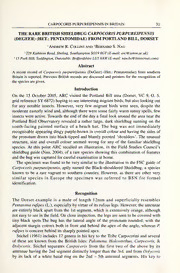
The rare British shieldbug Carpocoris purpureipennis (Degeer) (Het.: Pentatomidae) from Portland Bill, Dorset PDF
Preview The rare British shieldbug Carpocoris purpureipennis (Degeer) (Het.: Pentatomidae) from Portland Bill, Dorset
CARPOCORISPURPUREIPENNISINBRITAIN 31 THERAREBRITISHSHIELDBUGCARPOCORISPURPUREIPENNIS (DEGEER) (HET.: PENTATOMIDAE)FROMPORTLANDBILL,DORSET 1AndrewR. Collins and2BernardS. Nau 1228KathleenRoad, Sholing, SouthamptonS0198GY(E-mail:[email protected]) 215ParkHill, Toddington, Dunstable,BedfordshireLU56AW(E-mail:[email protected]) Abstract A recent record of Carpocorispurpureipennis (DeGeer) (Het.: Pentatomidae) from southern Britain is reported. Previous British records are discussed and pointers for the recognition of thespeciesaregiven. Introduction On the 15 October 2005, ARC visited the Portland Bill area (Dorset, VC 9, O. S. gridreference SY 6872) hoping to see interesting migrantbirds, but also looking out for any notable insects. However, very few migrant birds were seen, despite the moderateeasterly windand, althoughthere were somefairly warm sunny spells, few insects were active. Towards the end ofthe day a final look around the areanearthe Portland Bird Observatory revealed a rather large, dark shieldbug sunning on the south-facing painted surface of a beach hut. The bug was not immediately recognisable appearing dingy purple-brown in overall colour and having the sides of the pronotum drawn into black-tipped and bluntly pointed ‘shoulders’. The unusual structure, size and overall colour seemed wrong for any of the familiar shieldbug species. At this point ARC recalled an illustration, in the Field Studies Council’s shieldbug guide (Nau, 2004), ofarare species showing this combination offeatures andthebugwascapturedforcarefulexaminationathome. The specimen was found to be very similar to the illustration in the FSC guide of Carpocorispurpureipennis aptly named the Black-shouldered Shieldbug, a species , known to be a rare vagrant to southern counties. However, as there are other very similar species in Europe the specimen was referred to BSN for formal identification. Recognition The Dorset example is a male of length 12mm and superficially resembles Pentatoma rufipes(L.), especiallybyvirtueofitsrufous legs. However, theantennae are entirely black apart from the 1st segment, which is extensively orange, although noteasy to see in the field. On close inspection, the legs are seen to be covered with tiny black spots.The bug has the lateral angle of the pronotum rounded, with the adjacent margin convex both in front and behind the apex ofthe angle, whereas P. rufipesisconcavebehindits sharplypointedapex. Stichel (1961) includes 17 genera in his key to the Tribe Carpocorini and several of these are known from the British Isles: Palomena, Holcostethus, Carpocoris, & Dolycoris. Stichel separates Carpocoris from the first two of the above by its antennae having the 2nd segment distinctly longer than the 3rd, and from Dolycoris by its lack of a white basal ring on the 2nd - 5th antennal segments. His key to . 32 ENTOMOLOGIST'SRECORD,VOL. 118 25.i.2006 species of Carpocoris then deals with six species. Carpocorispudicus Poda and C. melanocerus Mulsant & Rey are ruled out by the shape ofthe outer edge scutellum where the taper angle changes; this has a marked indentation not present in the Portland bug. Carpocoris cyrenaicus Tamanini is eliminated by its long rostrum, which extends well beyond the hind coxae, but which in purpureipennis does not reach beyond the hind coxae. At this point in the key the male claspers (parameres) have to be examined microscopically to distinguish between C. purpureipennis C. , mediterraneus Tamanini and C fuscispinus (Boheman). Specifically, the position of . the end of a keel, along the outer periphery of the curved clasper, relative to the position of a ‘tooth’ on the inner margin. In the Portland bug, the keel terminates before the ‘tooth’, eliminating C. mediterraneus and C fuscispinus and identifying . thepresentbugas C purpureipennis . PlateE.Carpocorispurpeipennis, PortlandBill,Dorset, 15.X.2005,A.R. Collins. CARPOCORISPURPUREIPENNISINBRITAIN 33 Nomenclatureand previousrecords Barclay and Nau (2001) review previous records of Carpocoris species in Britain and describe an example ofC. purpureipennis found in a collection ofinsects made by students near Bristol on 4 October 1995 (the specimen illustrated in Nau, 2004). This appears to be the only other recent record of a shieldbug of this genus in Britain. The records which pre-date the Bristol example are more difficult to interpret. The few listed by Southwood and Leston (1959) under the name C. pudicus (Poda) are considered likely to refer collectively to C. purpureipennis (DeGeer) and C. mediterraneus Tamanini (Southwood & Leston, 1964). The most recent ofthese records dates from 1926 at Wye (Kent). The other records comprise another single in Kent, one in Essex, one in Cornwall and six in Devon. The current recordispresumedtobethefirsttohavebeen seeninDorset. Conclusions The observatory area at Portland Bill is remarkable forthe large numbers ofmigrant insects, especially Lepidoptera, that are recorded there. The present bug is the second continental species ofshieldbug to have been found here in 2005 (vide Slade et al., 2005). It seems highly likely that this example of Carpocorispurpureipennis was aprimary migrantanditisreasonable toanticipatethatfurtherexamples maybe found in the near future, given ongoing climatic amelioration. There has neverbeen anyevidenceofthis speciesbreedinginBritain, butthisisnowperhaps apossibility. References Barclay, M. V. L. and Nau, B. S., 2001. A recentrecord ofCarpocorispurpureipennis from the WestofEngland.Entomologists’MonthlyMagazine137:72. Nau, B. S., 2004. Guide to the Shieldbugs ofthe British Isles, Field Studies Council, AIDGAP guide. Slade, D., Collins, A. R., & Nau, B. S., 2005. Eurydema ornatum (L.) (Hem.: Pentatomidae) establishedontheDorsetcoastandakeytoEuropeanEurydemaspecies.EntomologistsRecord andJournalofVariation 117: 221-227. Southwood,T.R.E.andLeston,D., 1959.LandandWaterBugsoftheBritishIsles.Wame. Souintshewctoso.d2,nTd.eRd.iEt.ioann(dReLveissteodn),,DK.loe(t1,96G4.)S,.“&SuHbionrcdkesr,:W.HDe.t,er(oepdt.)e.raR”oyian:lAEntcohmeoclkogliisctaolfSBorciiteitsyh ofLondon,HandbooksfortheidentificationofBritishinsects,Vol.XI,Part 1. Stichel, W., 1961. IllustrierteBestimmungstabellender Wanzen. IIEuropa, vol. 4, bookpubl. by W.Stichel,Berlin.
